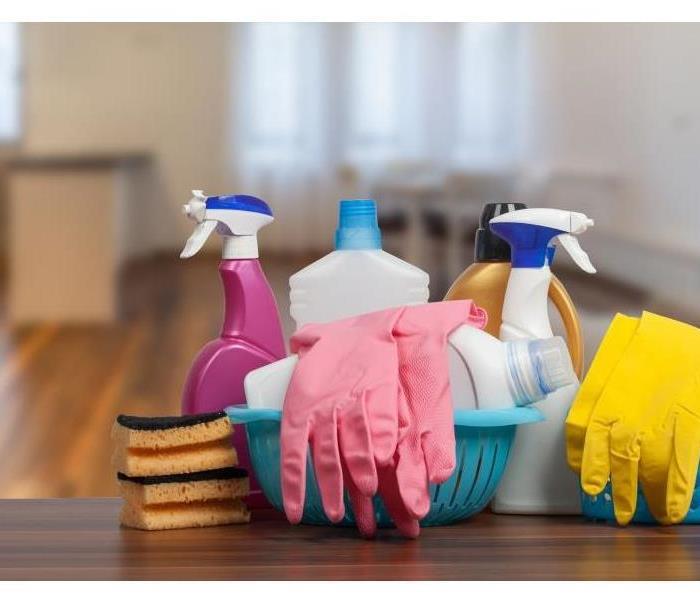Commercial Cleaning 101: Clean, Sanitize & Sterilize
5/22/2020 (Permalink)
What is the difference between cleaning, sanitizing, and disinfecting? You might be tempted to say that, there is, in fact, no difference between them. All of those terms basically mean clean something right? Hopefully you commercial cleaning company will disagree with you on this point. The language and science of cleaning has evolved, and will continue to evolve and grow more complex as the industry expands to meet the needs of an ever-changing marketplace. While it is the responsibility of your commercial cleaning company to keep up, as a Facility Manager, it is wise to have a handle on some of the basic terms. Should you be on the look out for a new commercial cleaning company, understanding some of the industry terms can help you keep prospective janitorial service companies on their toes and ask all the right questions. Have you ever wondered what the difference is between cleaning, sanitizing and disinfecting? Want to know what pathogens are & why your commercial cleaning company should too? We have the answers to your burning cleaning questions. We’ve put together a list of some key terms that will undoubtedly be useful to know:
Cleaning: Most of us would like to think we know this one! But surprisingly, cleaning only refers to removing visible gunk from a surface.
Mechanical Cleaning: Good, old fashioned elbow grease. Mechanical Cleaning is when you put away the fancy tools and give the surface a good scrubbing.
Sanitize: Sanitizing isn’t the same as cleaning. Think about hand sanitizer for a moment. Put it on dirty hands and they aren’t magically clean, just de-germed if you will. In your building, before a surface can be sanitized it should be cleaned. Then, an antimicrobial solution is applied for a specific dwell time to achieve the desired 99.9999% bacterial and viral kill rate.
Dwell Time: This is a word you would only know if you spend your time reading the back of cleaning products! You might not do that but we do. Dwell times refer to how long an antimicrobial or disinfectant solution must be left on a pre-cleaned surface before it can be considered sanitized or disinfected. The product needs a specific amount of time to do its intended job. This one is important because if your cleaning company is rushing through their work and not following manufacturer recommendations, you will not get as safe, healthy and effective as possible.
Sterilize: To sterilize something requires the almighty autoclave or something equally as powerful to insure a 100% kill rate on microorganisms, viruses, and any type of fungal spore. For those of you that have seen an autoclave before, you know that this isn’t a practical cleaning solution for a big, busy building and for that reason is only used on medical and dental tools as necessary.
Microorganism:The word you missed on your high school biology test has come back to haunt you. All a microorganism is is any bacteria, virus, or spore that can’t be seen without a microscope.
Pathogen: When microorganisms turn evil. Any microorganism that can cause illness or disease is a pathogen.
Hot Spots: Similar in nature to the touch point. Hot spots are areas within a building that are frequently traversed and touched, like handles, shared business machines, any surface, knob, handle, switch or the like. These areas need extra attention to make sure that they are truly clean because as they are touched often and by many, they become the perfect little hubs for the evil pathogens, those microorganisms intent on making you, your employees and building’s visitors sick.
Bactericide: When life gets to be a little too much for the bacteria. A bactericide is any solution that is specifically targeted to destroy bacteria.
Touch Points: The locations in your office or workplace that are touched the most often. Knowing the touch points in your workplace lets you know which areas need special attention because these areas see many hands and many hands see many mouths and noses which see many microorganisms, many of which are pathogens.
Team Cleaning: With team cleaning, a building is divided by duties, not zones so team members specialize. There may be one vacuum specialist, one restroom specialist, one duster and light duties specialist and similar. This specialization of members of a team creates more efficient, more consistent results and reduces training costs and equipment costs and well as increases accountability and professionalism.
Zone Cleaning: In zone cleaning a building is divided into zones, sometimes floors or areas and there is one cleaner to one zone. This is an outdated cleaning style that is inefficient because it results in duplicated equipment and inconsistent results.
Cleaning for Health: Unsurprisingly, exactly what it sounds like. Cleaning for health is not only to clean to make something visually appealing, but also to sanitize a surface to prevent the spread of those pesky pathogens and other microorganisms.
Smart Cleaning: Smart cleaning uses a detailed analysis of your building to provide customized solutions to reduced budgets and cuts by optimizing services and identifying livable service cuts and scheduling services in a way that balances your budget and building maintenance needs.
Cross Contamination: When you use the same rag on to wipe the break room lunch tables that you used on the restroom toilets, things don’t get too clean. In fact, they get even dirtier are germs, microorganisms and pathogens are spread around the various parts of your facility. This is called cross contamination and the best way to address it is with a color coded cloth system, team cleaning, proper product use like utilizing dwell times and manufacturer recommendations and other janitorial best practices.
If you have any other questions, feel free to call SERVPRO of Columbia and Suwannee Counties.




 24/7 Emergency Service
24/7 Emergency Service
